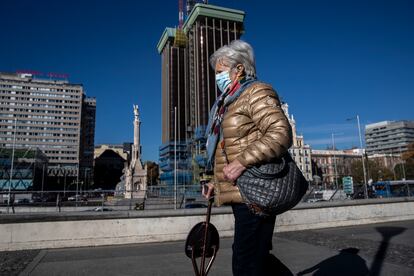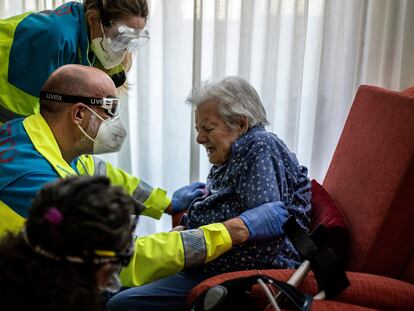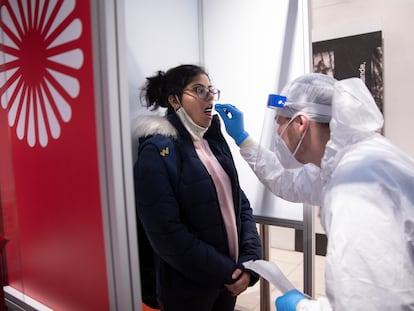Madrid region to lift mobility restrictions in 13 areas
But a section of the city of Móstoles is being added to the list of zones where people may enter or exit only on essential business

Madrid regional health authorities will lift mobility restrictions in 13 areas starting on Monday due to improved coronavirus figures. These 13 basic health zones – which are not districts or neighborhoods but areas served by one or more primary healthcare centers – have experienced drops of over 50% in the number of new cases and a sustained downward trend in the incidence rate.
On the other hand, a new basic health zone is being added to the list of areas where entering and leaving are only allowed for work, school and other essential business. It is a health zone known as Barcelona, located in the city of Móstoles, the Madrid region’s second-most-populated municipality after the capital itself. The restrictions are being imposed for 14 days beginning on Monday.
The basic healthcare zones where confinement is being lifted are the following:
In the city of Madrid – Entrevías, Pozo del Tío Raimundo, Alcalá de Guadaíra and Numancia (district of Puente de Vallecas), Pavones and Vandel (district of Moratalaz) and Infanta Mercedes (district of Tetuán).
Elsewhere in the Madrid region – San Juan de la Cruz (Pozuelo de Alarcón), Cerro del Aire and Valle de la Oliva (Majadahonda), Colmenar Viejo Norte (Colmenar Viejo) and the entire municipalities of Morata de Tajuña and Villarejo de Salvanés.
In total, there will be 18 basic health zones with mobility restrictions on Monday, down from 30 this Friday (see box below for the list). The measures will affect 381,505 people, or 5.7% of the population of the Madrid region. These areas account for 8% of infections.
Curfew and Christmas

Additionally, other measures remain in place such as the midnight-to-6am curfew and the limit of six people on social gatherings, either in public or private settings. There are also limits on attendance and opening hours at bars, restaurants, retail stores, gyms and places of worship.
The Madrid region as a whole will also close its borders between December 4 and 13, coinciding with two holidays that fall within that period – Constitution Day and the feast of the Immaculate Conception – when a lot of travel normally takes place.
As for the Christmas holidays, the regional government is proposing to let up to 10 people come together on December 24, 25 and 31 and on January 1 and 6. It also wants to push the curfew forward to 1.30am on Christmas Eve and New Year’s Eve. The rest of the time, the current six-person limit would remain in place. Madrid authorities may also allow outings for residents of senior homes and centers for people with disabilities who have had a positive PCR test in the previous three months or who have been shown to have IgG antibodies in the last six months.
Antigen tests
Madrid regional officials also said that they will ask the central government for permission to let pharmacies perform antigen tests to determine whether a person is infected with the coronavirus. “We will send [the request] today to the ministry, and if there is a positive reply, I think we’d be talking about the month of December,” said the regional health chief, Enrique Ruiz Escudero. The diagnostic test could be administered at around 500 of the 2,880 pharmacies operating in the region, said officials.
Antigen tests are faster and cheaper than PCR tests, which require sending samples to a lab, but they are also considered less reliable. Antigen tests are generally recommended for people who have had symptoms for two to five days, or who have had close contact with a positive case.
After leading the statistics for weeks, the Madrid region appears to be flattening the coronavirus curve. The 14-day cumulative number of coronavirus cases per 100,000 inhabitants has dropped to 252, the lowest on the mainland, compared with the national average of 325.
AREAS WITH RESTRICTIONS
Besides the basic health zone of Barcelona in Móstoles, where movement will be restricted until December 13, there are other zones where perimeters will remain sealed until December 6: Vicálvaro-Artilleros (district of Vicálvaro), Guzmán el Bueno (district of Chamberí), Daroca and La Elipa (district of Ciudad Lineal) in the city of Madrid; Cuzco, Alicante and Castilla la Nueva in the municipality of Fuenlabrada, La Moraleja in Alcobendas, Sierra de Guadarrama, Collado Villalba Pueblo and Collado Villalba Estación in Collado Villalba, El Boalo in Manzanares El Real; Moralzarzal; Colmenar de Oreja, Chinchón and Villaconejos in Colmenar de Oreja, as well as the entire municipalities of San Martín de Valdeiglesias and Pelayos de la Presa.
English version by Susana Urra.
Tu suscripción se está usando en otro dispositivo
¿Quieres añadir otro usuario a tu suscripción?
Si continúas leyendo en este dispositivo, no se podrá leer en el otro.
FlechaTu suscripción se está usando en otro dispositivo y solo puedes acceder a EL PAÍS desde un dispositivo a la vez.
Si quieres compartir tu cuenta, cambia tu suscripción a la modalidad Premium, así podrás añadir otro usuario. Cada uno accederá con su propia cuenta de email, lo que os permitirá personalizar vuestra experiencia en EL PAÍS.
¿Tienes una suscripción de empresa? Accede aquí para contratar más cuentas.
En el caso de no saber quién está usando tu cuenta, te recomendamos cambiar tu contraseña aquí.
Si decides continuar compartiendo tu cuenta, este mensaje se mostrará en tu dispositivo y en el de la otra persona que está usando tu cuenta de forma indefinida, afectando a tu experiencia de lectura. Puedes consultar aquí los términos y condiciones de la suscripción digital.
More information
Últimas noticias
Most viewed
- Oona Chaplin: ‘I told James Cameron that I was living in a treehouse and starting a permaculture project with a friend’
- Reinhard Genzel, Nobel laureate in physics: ‘One-minute videos will never give you the truth’
- Sinaloa Cartel war is taking its toll on Los Chapitos
- Why the price of coffee has skyrocketed: from Brazilian plantations to specialty coffee houses
- Silver prices are going crazy: This is what’s fueling the rally










































